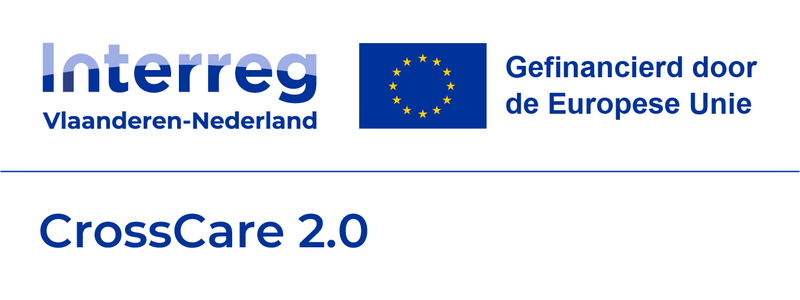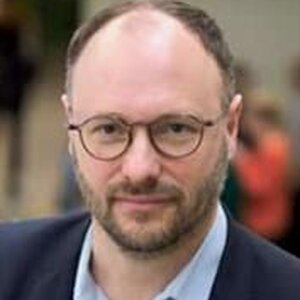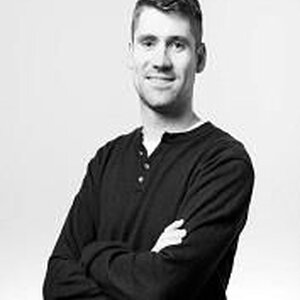CrossCare 2.0 is een grootschalig Europees programma waarbij acht Vlaamse en Nederlandse zorgproeftuinen de ontwikkeling van nieuwe zorginnovaties in Vlaanderen en Nederland financieel en inhoudelijk ondersteunen.

Dit project wordt mogelijk gemaakt door de steun van Interreg Vlaanderen-Nederland, VLAIO - Agentschap Innoveren & Ondernemen en Provincie Oost-Vlaanderen.


Odisee voorziet binnen CrossCare 2.0 de impactmeting en evaluatie van zorginnovatietrajecten, de zorgproeftuin-dienstverlening en het globale CrossCare 2.0 traject. We willen daarbij streven naar een meer wetenschappelijk en onderbouwde manier om de potentiële en effectieve impact van zorginnovaties in kaart te brengen. Er worden wetenschappelijk onderbouwde meetinstrumenten aangewend om hun beoogde en uiteindelijke gerealiseerde impact te kwantificeren, beoordelen en vergelijken. We nemen hiervoor relevante parameters mee in rekening op economisch, maatschappelijk en ecologisch vlak. Maak kennis met de probleemstelling waarrond dit project is opgezet en op welke manier we hier samen met 8 verschillende partners uit Vlaanderen en Nederland de komende twee jaar zullen op werken.

Innovatie als mogelijk antwoord op de groeiende maatschappelijke zorgvragen en -noden
De zorgvragen en -noden in de Nederlandse en Vlaamse samenleving worden steeds talrijker, diverser en complexer. Maatschappelijke en demografische ontwikkelingen zoals de vergrijzing, de opkomst van complexe langdurige zorg- en ondersteuningstrajecten, de hogere verwachtingen en eisen van zorggebruikers, … spelen hier onder andere een belangrijke rol in en zijn langs beide zijden van de grens merkbaar. Daarnaast is ook de groeiende personeelsschaarste in de ruime sector ‘zorg en welzijn’ één van de grote uitdagingen op de arbeidsmarkt. De organisatie, toegankelijkheid en betaalbaarheid van het zorgsysteem komt onder druk te staan. Een succesvolle ontwikkeling en implementatie van zorginnovaties kan in die zin op diverse fronten mogelijke antwoorden bieden op de vele uitdagingen waarmee de sector geconfronteerd wordt.
Complexe innovatietrajecten in een gefragmenteerde en moeilijk toegankelijke markt
We stellen vast dat innovatietrajecten in de concrete zorg- en welzijnssector vaak nog moeizaam en/of beperkt ontwikkeld, geïmplementeerd en/of opgeschaald worden. Het is bekend dat vele innovatieve ideeën nooit effectief op de markt komen. Innovatoren/ontwikkelaars hebben soms weinig voeling met de sector en/of botsen vaak op verschillende belemmeringen in de sector (gefragmenteerde markt, complexe protocollen en regels, ..). De marktintroductie van veel technologische innovaties faalt met name ook doordat ze te weinig zijn afgestemd op behoeften en gedragingen van eindgebruikers of onvoldoende inpassen in diensten, processen, structuren of bestaande businessmodellen van zorg- en welzijnsorganisaties.
De inbreng van zorgproeftuinen als katalysatoren en bruggenbouwers
Binnen die context, van zorg-innovaties die een moeilijke marktintroductie kennen, moet de meerwaarde van de zorgproeftuinen gesitueerd worden. Innoveren heeft een prijskaartje en dus is een adequate en efficiënte innovatiestrategie geen overbodige luxe. Om te zorgen dat een innovatie goed in de zorgpraktijk landt, is het belangrijk om het zorglandschap goed te kennen, te weten welke partijen en actoren daarin een rol spelen en wat hun belangen, wensen en behoeften zijn. Zorgproeftuinen kunnen daarin een belangrijke rol spelen en een betere verbinding tot stand brengen tussen technologie, samenleving en economie door een brug te slaan tussen de technologische ontwikkeling van producten en diensten enerzijds en de noden, voorkeuren en behoeften van zorg-eindgebruikers anderzijds. Een zorgproeftuin begeleidt ontwikkelaars van zorginnovaties met name om samen met eindgebruikers, nieuwe of verbeterde zorgconcepten, -diensten, -processen en -producten te creëren en te toetsen in de praktijk. De eindgebruiker (een patiënt, een cliënt, een burger, een zorgprofessional, ...) staat in deze trajecten dus niet enkel centraal bij het evalueren, maar ook bij de ontwikkeling, uitwerking en bijsturing van de zorginnovaties.
Rol Odisee Hogeschool
Odisee Hogeschool zal de impactmeting en evaluatie opnemen vanuit twee van haar onderzoekscentra, Zorginnovatie ('Zinn') en Center for Sustainable Entrepreneurship ('CenSe'). De finale doelstelling van ons werkpakket is daarbij drieledig. Eerst en vooral wil het werkpakket de doelmatigheid en impact van innovatietrajecten in kaart brengen. Bedoeling is dat we deze onderbouwde impactprognose van de innovatietrajecten niet enkel post factum aftoetsen in de evaluatie, maar ook actief integreren en mee in overweging nemen tijdens de selectie- en evaluatieprocedure. Daarnaast wil dit werkpakket ook de effecten van de zorgproeftuin-dienstverlening en van het globale CrossCare 2.0 programma verder onderzoeken en documenteren. We willen zo de grensoverschrijdende impact van het globale project als accelerator van innovatie in kaart proberen te brengen (voor zowel deelnemende partijen, stakeholders, eindgebruikers als de maatschappij in haar geheel).
Projectpartners
Vlaanderen: LiCalab/Thomas More Kempen (provincie Antwerpen), Zorglab Aalst (provincie Oost-Vlaanderen), Happy Aging (provincie Vlaams-Brabant & Limburg) en Eerstelijnszone Brugge in samenwerking met de POM-West-Vlaanderen (provincie West-Vlaanderen).
Nederland: Care Innovation Center (provincie Noord-Brabant), Zuyd Hogeschool/EIZT (provincie Limburg), Coöperatie Slimmer Leven in samenwerking met Brainport Development (provincie Noord-Brabant) en HZ University of Applied Sciences (provincie Zeeland).
Wil je meer weten over dit project?
Maak kennis met de onderzoekers
Working towards a safer MR environment supported by a European Curriculum for Safety Officers in Magnetic Resonance Imaging (ECSO-MRI)

Co-funded by the Erasmus+ Programme of the European Union - KA220 [2022-1-BE02-KA220-HED-000085873]

The aim of this project is to develop a European Curriculum for Safety Officers in Magnetic Resonance Imaging (MRI). Many issues related to this topic emerged in discussions we had with our alumni. So, the idea grew to develop a MR Safety program and we reached out to our European partners.
Because our target group is very divers we want to stimulate and increase sharing knowledge in MR Safety. We want to deploy the necessary educations technology to support a transnational common curriculum. From an educational perspective we need to find a balance between the learning preferences from our target group and the curriculum design. And this all is needed so we can work together moving towards a safer MR Environment.

The research group will design a curriculum who is compliant to the MRSO descriptor role so we can maintain quality across out teaching institutions. We will create e similar vision about teaching, learning and assessment in a transnational blended learning environment.
The curriculum will be developed in a modular structure which includes a basic MR safety module (± 10 ECTS) and modules for magnetic resonance safety officer (MRSO) education and training (± 20 ECTS). Each course module will have a module descriptor which states the module aim(s), teaching and learning methods, description of study materials, competencies that will be achieved on successful completion of each module. The produced/ developed course materials may include lecture notes, video recordings, scientific articles, PowerPoint presentation, learning exercises and assignments. The delivered curriculum will be integrated in an e-learning platform by the aid of educational technology. This e-learning platform will have a consistent structure throughout all course modules, a noticeable learning pathway for the target group and will facilitate independent student learning and self-testing (asynchronous) to monitor study progress.

InHolland University of Applied Sciences, April 2023

University of Malta, September 2023

University College Dublin, February 2024
Module descriptors
Basic Course
The aim of the basic MRI safety course (10 ECTS) is to provide a foundation in MRI safety, leading to an awareness of the risks that are present for staff and patients within the MRI department. Topics covered will all be focussed on MRI safety and will range from the basics of magnetism through to the bioeffects of the different electromagnetic fields used in MRI. The basic course will also address contrast agents used in MRI, screening of patients and staff, and the basic concepts of suite design.
Advanced Course
The advanced course (20 ECTS) will be focussed on developing the basic concepts of MRI safety addressed in the basic course to a more advanced level. All aspects regarding the radiofrequency electromagnetic field, static magnetic field and gradient magnetic field will be explored in more detail, with in-depth correlation to clinical practice. Emphasis will be placed on risk assessment of passive and active implants. The advanced course will provide MRI personnel with the knowledge and skills required to be confident decision makers, dealing with issues that arise in the day to day running of the MRI unit to the level of an MRI safety officer. It will enable them to be key members and decision makers on the MRI safety committee within their organisation.
About the program
Like to apply?
Are you interested in upgrading your knowledge about MRI safety which will provide you with a greater awareness of the risks and with the knowledge and skills to the level of an MRI safety officer working in the MRI environment? And do you have a relevant qualification and experience working in the MRI environment?
Please contact our partner university of your country and subscribe for (one or both of) the modules.
In regard of the wholeness of the program, your input will be considered as useful. Hereby you can find the link to the different surveys in which your input is asked.
Partners
- InHolland University of Applied Sciences: Harmen Bijwaard, Anja van Diepen, Jelle Scheurleer
- University College Dublin: Allison McGee, Andrea Cradock, Jonathan McNulty
- Turku University of Applied Sciences: Jarno Huhtanen, Säde Huhtanen
- Tampere University of Applied Sciences: Anna-Riikka Keihäs, Pirita Markkula
- University of Malta: Francis Zarb, Jonathan Portelli, Susan Mercieca
- European federation of radiographer societies: Andrew England, Vitor Silva
Want to know more about this project?
Co-funded by the Erasmus+ Programme of the European Union - KA220 [2022-1-BE02-KA220-HED-000085873]














